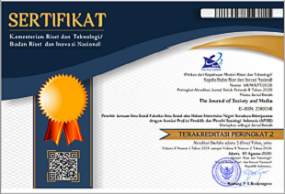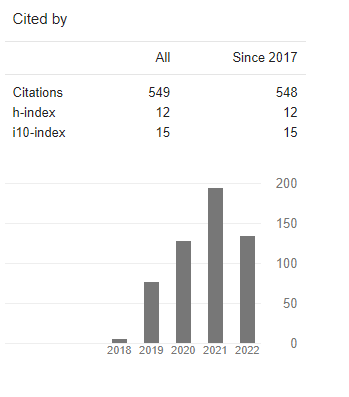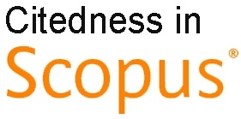Communication Patterns and Media Technology Role in Organization and Society During Pandemic
DOI:
https://doi.org/10.26740/jsm.v4n2.p228-261Keywords:
communication, Work From Home, covid-19Abstract
The covid-19 pandemic as the background of the Work From Home (WFH) policy is believed to have increased significant participation in communication technology and changed communication patterns. The research aims to know the implementation of WFH during the pandemic, the use of communication technology, the communication patterns during WFH that have changed from face-to-face to Computer-Mediated Communication (CMC), and the essential factors for the success of WFH. A qualitative method with a descriptive case study approach and a semi-structured interview technique is used. The theory is media richness theory. The results showed that WFH offered advantages and disadvantages for employees and organizations. WFH featured various types of technology/media, from lean to rich. Communication technology plays an essential role during WFH, which causes changes in communication patterns. Different technologies/media vary in their ability to reproduce messages. During WFH, CMC creates a different climate than face-to-face communication because CMC is less affluent than face-to-face communication. In implementing WFH, even after the pandemic, it is necessary to pay attention to the needs of organizations and employees and the main factors of successful WFH implementation so that WFH can be as effective as working in an office.
References
Budhiekusuma, Noor Patria, Sasongko Pramono Hadi, and Wing Wahyu Winarno. 2017. œTelecommuting Application Opportunity in Indonesian Government (Peluang Pemanfaatan Telecommuting Dalam Pemerintahan Di Indonesia ). Journal Pekommas 2(2):151. DOI: 10.30818/jpkm.2017.2020205.
Bai, John (Jianqiu), Erik Brynjolfsson, Wang Jin, Sebastian Steffen, and Chi Wan. 2020. œThe Future of Work: Work From Home Preparedness and Firm Resilience During the Covid-19 Pandemic. Corporate Finance: Governance 120. DOI:10.2139/ssrn.3616893.
Cardenas, Jeisson. 2020. œMeasuring the Share of Workers in Work-from-Home and Those in Close Personal Proximity Occupations in a Developing Country. Colombia Cientifica. DOI: 10.13140/RG.2.2.22995.73766.
Chong, Sin Hui, Yi Huang, and Chu Hsiang Daisy Chang. 2020. œSupporting Interdependent Telework Employees: A Moderated-Mediation Model Linking Daily COVID-19 Task Setbacks to Next-Day Work Withdrawal. Journal of Applied Psychology. DOI: 10.1037/apl0000843.
Daft, R. L., and R. H. Lengel. 1984. œOrganizations as Information Processing Systems, Information Richness: A New Approach to Managerial Behavior and Organization Design. Research In Organizational Behavior 6:191233. DOI: 10.21236/ada128980 N00014-83-C-0025.
December, John. 1996. œUnits of Analysis for Internet Communication. Journal of Communication. DOI: 10.1111/j.1460-2466.1996.tb)1459.x.
Dennis, Alan R., and Joseph S. Valacich. 1999. œRethinking Media Richness: Towards a Theory of Media Synchronicity. Proceedings of the Hawaii International Conference on System Sciences (January):12. DOI: 10.1109/HICSS.1999.772701.
Dubey, Akash Dutt, and Shreya Tripathi. 2020. œAnalysing the Sentiments towards Work-from-Home Culture during COVID-19 Pandemic. Journal of Innovation Management 1:1319. DOI: 10.24840/2183-0606_008.001_0003.
Eriyanto. 2018. Metode Penelitian Komunikasi. Universitas Terbuka.
Favale, Thomas, Francesca Soro, Martino Trevisan, Idilio Drago, and Marco Mellia. 2020. œCampus Traffic and E-Learning during COVID-19 Pandemic. Computer Networks 176(May). DOI: 10.1016/j.comnet.2020.107290.
Griffin, Em, Andrew Ledbetter, and Sparks. Glenn. 2019. COMMUNICATION. Mc Graw Hill Education.
Grobler, P. A., and A. J. De Bruyn. 2011. œFlexible Work Practices (FWP) - An Effective Instrument in the Retention of Talent: A Survey of Selected JSE-Listed Companies. South African Journal of Business Management 42(4):6378. DOI: 10.4102/sajbm.v42i4.506.
Gunawardena, C. 1995. œSocial Presence Theory and Implications of Interaction and Collaborative Learning in Computer Conferencing. International Journal of Educational Telecommunications 1(23):14766. DOI: 10.1111/j.1541-0420.2011.01694.x.
Hapsa, Kholistiani Puspadina, Uud Wahyudin, and Duddy Zein. 2019. œPerilaku Komunikasi Dan Makna Samawa Pada Pasangan Menikah Melalui TaAruf. Jurnal Riset Komunikasi 2(1):112. DOI: 10.24329/jurkom.v2i1.48.
Hope, Joan. 2020. œWorking from Home? Follow These Tips for Successful Remote Work. The Successful Registrar 20(3):99. DOI: 10.1002/tsr.30713.
Jackson, Leon T. B., and Edwina I. Fransman. 2018. œFlexi Work, Financial Well-Being, WorkLife Balance and Their Effects on Subjective Experiences of Productivity and Job Satisfaction of Females in an Institution of Higher Learning. South African Journal of Economic and Management Sciences 21(1). DOI: 10.4102/sajems.v21i1.1487.
Jasmine, Ceilla Amanda. 2020. œImpacts of Covid-19 on Company and Efforts to Support Organization Adaptable. (March). DOI: 10.2139/ssrn.3590726
Király, Orsolya, Marc N. Potenza, Dan J. Stein, Daniel L. King, David C. Hodgins, John B. Saunders, Mark D. Griffiths, Biljana Gjoneska, Joël Billieux, Matthias Brand, Max W. Abbott, Samuel R. Chamberlain, Ornella Corazza, Julius Burkauskas, Célia M. D. Sales, Christian Montag, Christine Lochner, Edna Grünblatt, Elisa Wegmann, Giovanni Martinotti, Hae Kook Lee, Hans-Jürgen Rumpf, Jesús Castro-Calvo, Afarin Rahimi-Movaghar, Susumu Higuchi, Jose M. Menchon, Joseph Zohar, Luca Pellegrini, Susanne Walitza, Naomi A. Fineberg, and Zsolt Demetrovics. 2020. œPreventing Problematic Internet Use during the COVID-19 Pandemic: Consensus Guidance. Comprehensive Psychiatry 100:152180. DOI: 10.1016/j.comppsych.2020.152180.
Knapp, Mark L., and John A. Daly. 2011. Interpersonal Communication. Sage Publications.
Lane, et al. 2020. œWorking from Home During the COVID-19 PANDEMIC¯: Tips and Strategies to Maintain Productivity & Connectedness. 17(5). DOI: 10.7191/pib.1145.
Leslie, Lisa M., Colleen Flaherty Manchester, Tae Youn Park, and Si Ahn Mehng. 2012. œFlexible Work Practices: A Source of Career Premiums or Penalties? Academy of Management Journal 55(6):140728. DOI: 10.5465/amj.2010.0651.
Lin, Lien-fa, Yung-ming Li, and Wen-hsiang Wu. 2015. œA Social Endorsing Mechanism for Target Advertisement Diffusion. Information & Management 52(8):98297. DOI: 10.1016/j.im.2015.07.004.
Lopez-Leon, Sandra, Diego Forero, and Paola Ruiz-DÃaz. 2020. œTwelve Tips for Working from Home. Medical Teacher Preprint(2):112. DOI: 10.35542/osf.io/yndcg
Mungkasa, Oswar. 2020. œBekerja Jarak Jauh (Telecommuting): Konsep, Penerapan Dan Pembelajaran. Bappenas Working Papers III(1):132. DOI: 10.47266/bwp.v3i1.52
Mustajab, Duta, Azies Bauw, Abdul Rasyid, Andri Irawan, Muhammad Aldrin Akbar, and Muhammad Amin Hamid. 2020. œWorking from Home Phenomenon as an Effort to Prevent COVID-19 Attacks and Its Impacts on Work Productivity. The Internationa Journal of Applied Business 53(9):168999. DOI: 10.1017/CBO9781107415324.004.
Nehls, Kimberly, Brandy D. Smith, and Holly A. Schneider. 2014. œVideo-Conferencing Interviews as a Data Collection Method. Information Science Reference (January):14057. d DOI: 10.4018/978-1-4666-6493-7.ch006.
Parthasarathy, Anand. 2020. œCoronavirus Challenge Propelling a New Paradigm of Work from Home. Science Reporter 1619.
Putri, Gloria Setyvani. 2020. œWHO Resmi Sebut Virus Corona Covid - 19 Sebagai Pandemi Global. Kompas.Com. (https://www.kompas.com/sains/read/2020/03/12/083129823/who-resmi-sebut-virus-corona-covid-19-sebagai-pandemi-global)
Rice, Ronald E. 1993. œMedia Appropriateness Using Social Presence Theory to Compare Traditional and New Organizational Media. Human Communications Research (1). DOI: 10.1111/j.1468-2958.1993.tb00309.x
Sabron, Mohd Zdikri Md, Rugayah Hashim, Aida Abdullah, and Nurshamshida Shamsudin. 2020. œThe Sequela of Smartphone Usage in the Learning Environment Mohd. Jounal of ASIAN Behavioural Studies 5(13):107. DOI: 10.21834/e-bpj.v5i13.1958.
Sethi, Subrat Kumar, and Saswati Paramita. 2016. œNetwork Technology Trend for Next-Generation Wireless Communication. The IUP Journal of Telecommunications VIII(2):1224.
Setiawan, Yasin, Zulkarnain Zulkarnain, and Nurjanah Nurjanah. 2020. œPengaruh Komunikasi Berbasis Komputer Terhadap Kualitas Pelayanan Perpustakaan Universitas Riau. Jurnal Riset Komunikasi 3(1):117. DOI: 10.24329/jurkom.v3i1.88.
Shin, Dong Hee, and Yong Jin Park. 2017. œUnderstanding the Internet of Things Ecosystem: Multi-Level Analysis of Users, Society, and Ecology. Digital Policy, Regulation and Governance 19(1):77100. DOI: 10.1108/DPRG-07-2016-0035.
Sundmaeker, Harald, Patrick Guillemin, Peter Friess, and Woelffle. Sylvie. 2010. Vision and Challenges for Realizing the Internet of Things. Cerp-IoT Cluster of European Research Projects n the Internet of Things. DOI: 10.2759/26127
Yang, Paul R., and Roy A. Meals. 2014. œHow to Establish an Interactive EConference and EJournal Club. Journal of Hand Surgery Am 39(1) : 12933. DOI: 10.1016/j.jhsa.2013.10.004.
Downloads
Published
How to Cite
Issue
Section
License
Copyright (c) 2020 The Journal of Society and Media

This work is licensed under a Creative Commons Attribution 4.0 International License.
 Abstract views: 4862
,
Abstract views: 4862
, PDF Downloads: 4628
PDF Downloads: 4628












